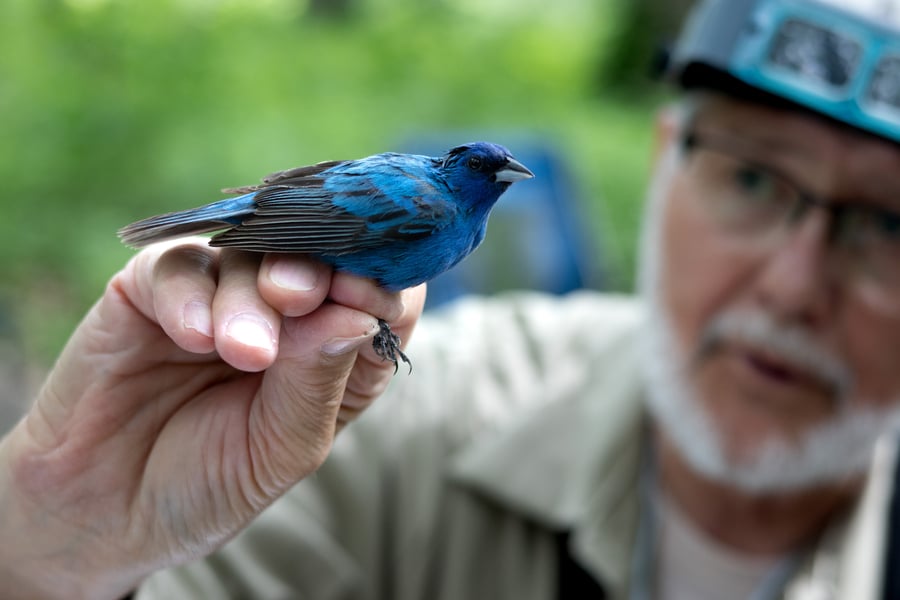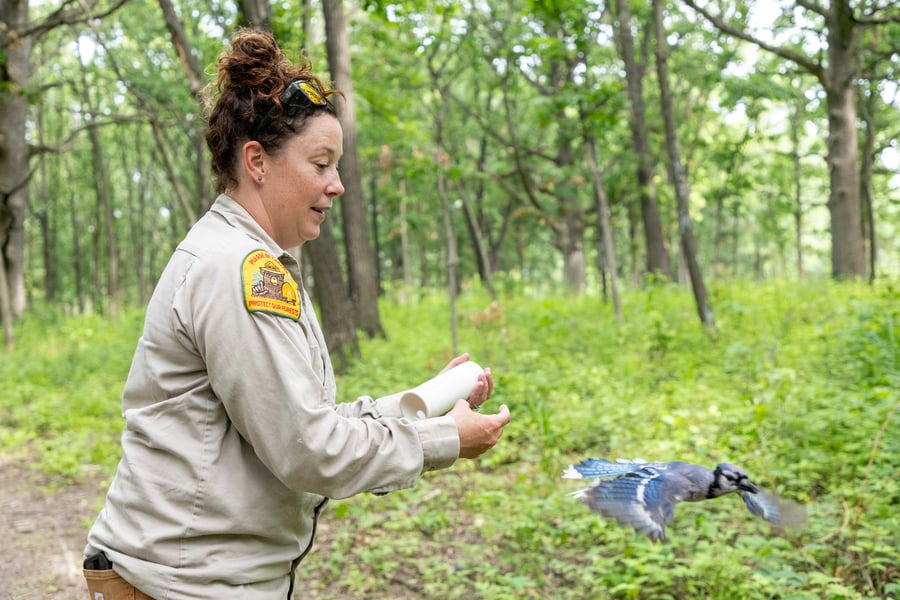
In early June 2025, Forest Preserve District staff with the Monitoring Avian Productivity and Survivorship program huddled around a remote forest preserve picnic table. On the table sat a scale, assorted PVC tubes, an open laptop, a cooler stuffed with ham sandwiches, and two thick red leather-bound books with miniscule print.
The books, collectively called Peter Pyle’s Identification Guide to North American Birds, Second Edition, are key to cataloguing birds for the MAPS program. (Read Banding Together, Part 1 for the basic workings of the capture program.)
After a bird is captured, a trained monitor uses one hand to gently grasp the winged creature and remove it from its temporary holding bag. Everyone is quiet, partly out of awe but mostly to not frighten the bird. At that point, Pyle’s book advises them how to determine the bird’s sex and age by looking at its plumage and measurements, among other features.
Offering an example, Forest Preserve District volunteer Glenn Gabanski opens to a random page of the guide (279, the eastern phoebe) and reads aloud.
“‛Molt limits occur among juveniles and formative wing coverts and tertials in September through August, the retained juvenile outer greater coverts brownish olive with dark buff tips when fresh, contrasting with olive and grayish-tipped replaced inner coverts,’” Gabanski reads. “There’s just so much detail.”

Forest Preserve District staff measure a red-bellied woodpecker.
In the decades researchers have gathered MAPS data in DuPage, Gabanski has remained the sole constant. The retired high school math teacher doesn’t have a degree in wildlife biology, but what he lacks in formal education he makes up for in passion.
“I first got interested in birds in the ’90s when I visited my sister in South Lake Tahoe,” he said. “She had me hold my hand out with some sunflower seeds in it, and a mountain chickadee came down and grabbed one. That’s what they now call the ‘spark,’ the thing that suddenly makes you interested in birds.”
That spark ignited an inferno. In 1991, when the national MAPS program was only in its second year, Gabanski joined the Chicago Audubon Society on a field trip to watch bird banders in action. Shortly thereafter, he started volunteering with the survey. In 2007 when oversite of the DuPage County MAPS program moved from the Chicagoland Bird Observatory to the Forest Preserve District, Gabanski moved with it.
Coming home from Lake Tahoe, Gabanski didn’t know a male from a female house sparrow. Today, his birding life list numbers nearly 1,000 species, many added as part of his involvement with MAPS.
Going back to 1992 (2005, 2006, and spring 2020 excluded), the greatest single day collection from mist nets at a MAPS station in DuPage County has been 39 birds. Within the larger MAPS network, that’s a drop in the bucket, but when combined with other agencies’ finds, it has an accumulative effect.
“Our station is small,” Forest Preserve District ecologist Brian Kraskiewicz explained. “It’s really a tiny amount of information we’re sharing, roughly 100 birds a year. You can’t really do a study with that alone, but if you have thousands of different stations, which MAPS has, and they all catch 100 birds, then you have data you can study.”

A blue jay is released back into the wild.
And studied it is. The Institute for Bird Populations lists nearly 300 publications conducted worldwide that have, at least in part, used MAPS data. Even though the information is relatively basic — size, weight, age — it informs research across a menagerie of disciplines. Recent topics have touched on entomology, climatology, evolution, and for one 2016 paper, the variation of a specific hydrogen isotope found in songbird feathers.
As the Forest Preserve District has done its part to study bird populations, it’s made history along the way. It holds the title for the second-oldest indigo bunting ever captured, a 9-year, 11-month-old female caught in 2014. And remember Peter Pyle’s identification guide? Both Gabanski and Kraskiewicz are mentioned in the acknowledgements.
By banding birds and tracking their movements, lifespans, and breeding behaviors, the District can monitor whether its 26,000 acres of preserves are functioning properly and supporting the integral role both native and migratory species play in nature.
Gabe Lareau
